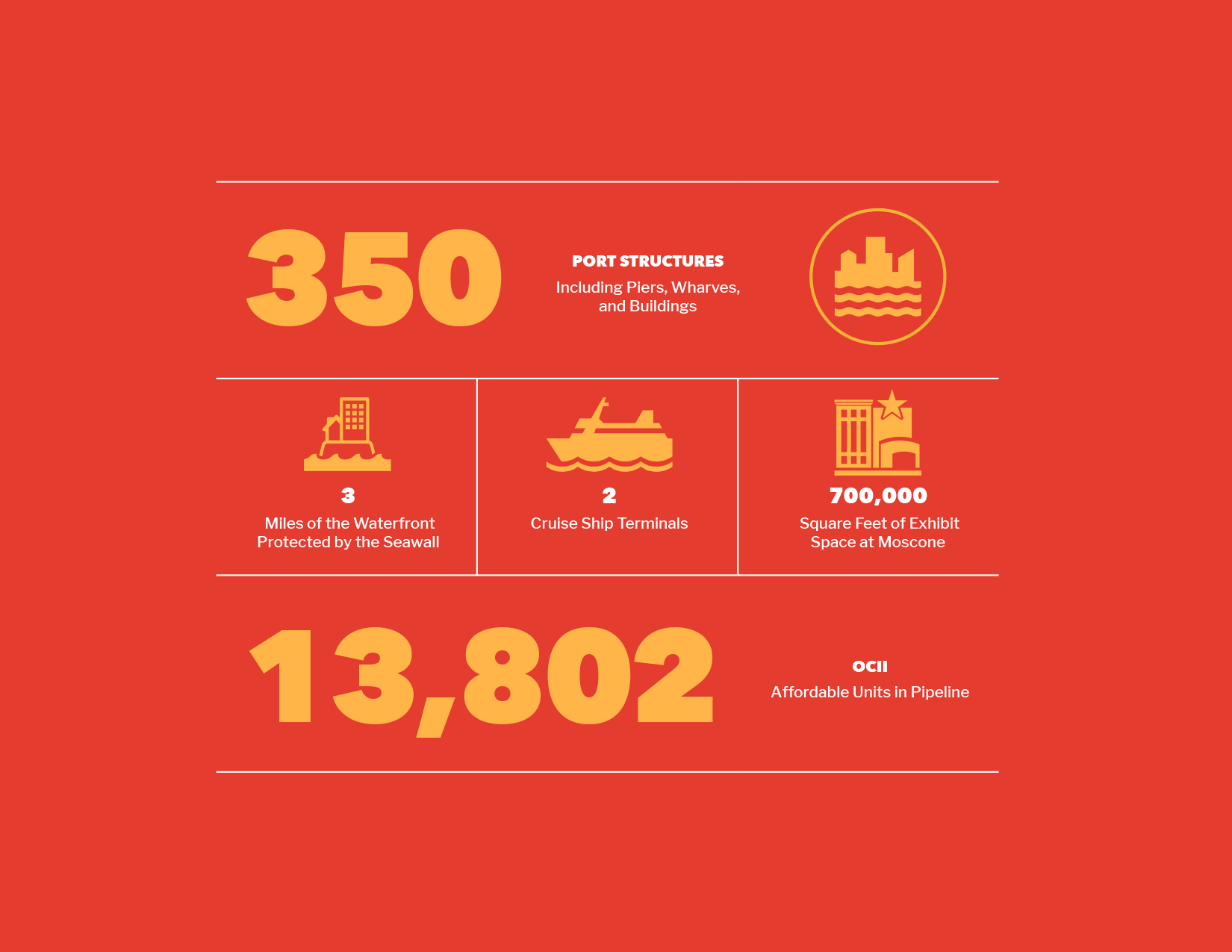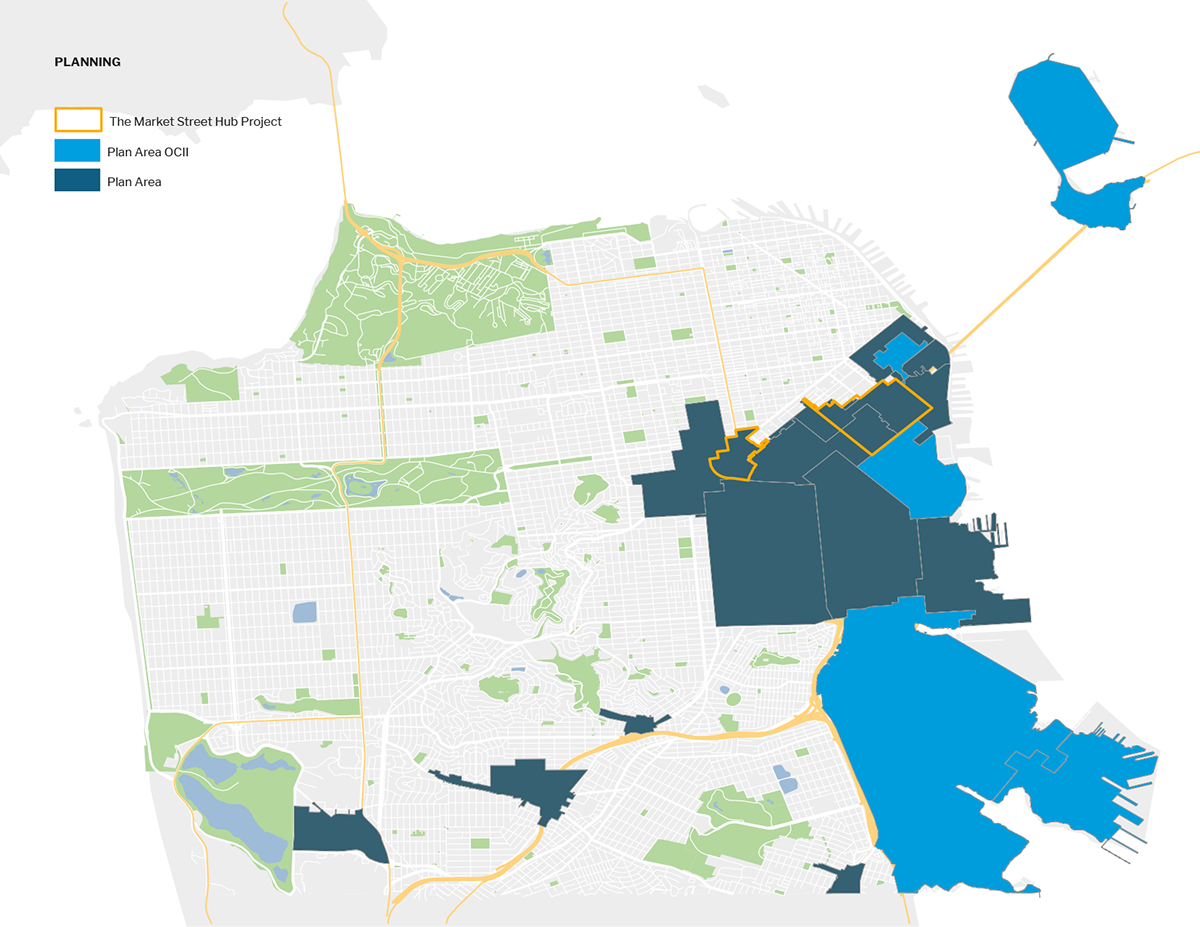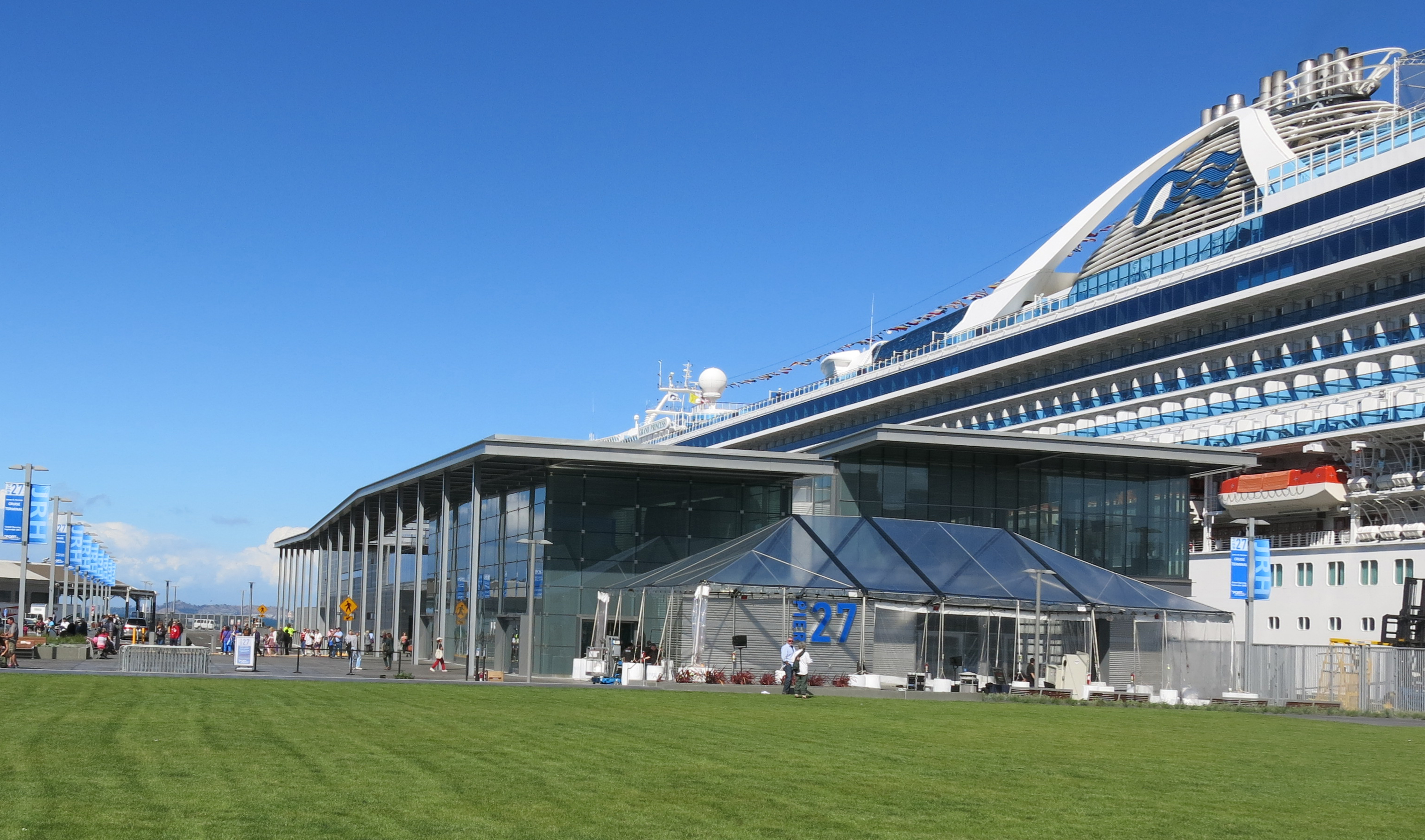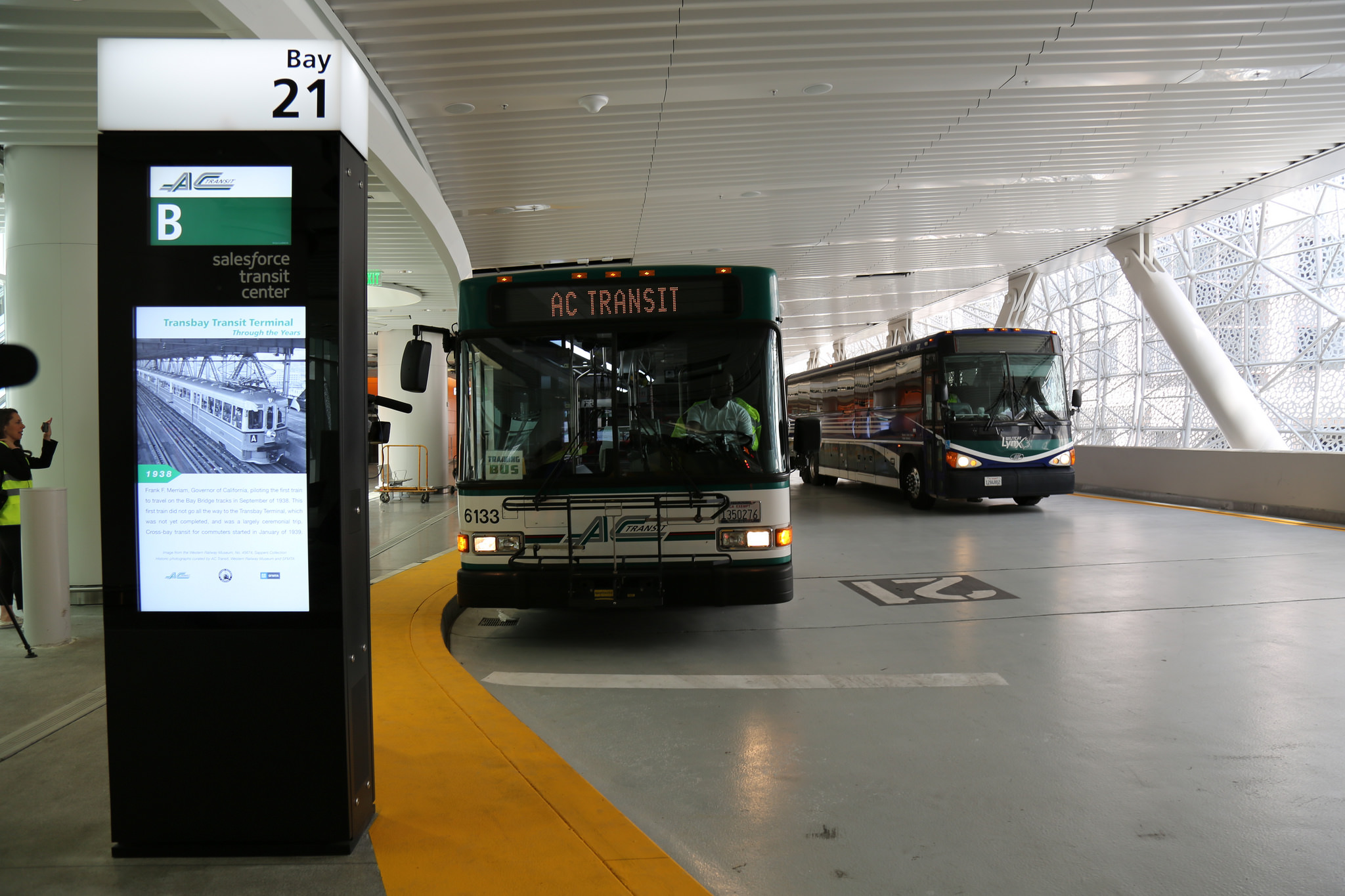OCII: Office of Community Investment and Infrastructure
PLANNING: Impact Development Plan Areas
PORT: Port of San Francisco
TIDA: Treasure Island Development Authority
San Francisco is growing as our neighborhoods, values, and economy continue to draw new residents. As of 2017 the population was 884,363, up 14% from 2000. Plan Bay Area, developed by the Association of Bay Area Governments, projects San Francisco will grow by 90,000 housing units and 190,000 jobs by 2040. As the city’s density increases, having sufficient infrastructure to support all residents in all neighborhoods becomes more challenging but also more important.
Real estate developments along the waterfront, the creation of new neighborhoods, and preparing existing neighborhoods for anticipated growth will increase the City’s infrastructure portfolio along with its tax base. Central SoMa, the Hub, Mission Bay, Candlestick Point, and Hunters Point Shipyards are just a few of the high-growth areas changing the face of San Francisco. Many of these developments and projects have distinctive funding mechanisms, including dedicated development fees and developer agreements that target improvements in areas of especially high growth. These projects seek to create well-planned, safe places to live, travel, work, and play.


This chapter includes capital projects from departments, agencies, and programs whose primary objectives are to improve San Francisco’s wide-ranging economic base and plan for its future growth.
Port of San Francisco
The Port of San Francisco is responsible for the 7.5 miles of San Francisco waterfront adjacent to San Francisco Bay. The Port manages, maintains, develops, markets, and leases all of the property in this area. The Port’s operating portfolio is composed of approximately 580 ground, commercial, retail, office, industrial, and maritime leases, including leases of many internationally recognized landmarks such as Fisherman’s Wharf, Pier 39, the Ferry Building, and AT&T Park, home of the San Francisco Giants baseball team.
Port lands must be used consistently with public trust principles for the benefit of all California citizens, to further navigation and maritime commerce, fisheries, public access and recreation, environmental restoration, and commercial activities that attract the public to the waterfront. Urban waterfront developments, including the new Southern Bayfront neighborhood developments proposed in the Mission Rock, Orton, and Forest City projects, require detailed coordination, review, and approval of many government agencies. The Port has also secured State legislation to allow non-trust uses of specified Port lands and created special financing districts to support waterfront improvements. Such advances were made possible by developing a common understanding with partner agencies of project objectives and requirements to restore historic structures and improve the waterfront for maritime and public use and enjoyment.
Caring for the Port’s many aging, historic structures while staying true to its public trust mission is a challenge. The Port’s need for capital investments has historically outpaced available funding, leaving a substantial backlog and requiring strategic decisions about how to best manage the Port’s aging assets. The Port has confronted this challenge with dedicated funds, pursuit of new external sources, and strategic prioritization.

Office of Community Investment and Infrastructure
The Office of Community Investment and Infrastructure is the successor agency to the San Francisco Redevelopment Agency, which was dissolved in 2012 by order of the California Supreme Court. OCII is authorized to continue to implement the Major Approved Development Projects, which include the Mission Bay North and South Redevelopment Project Areas (Mission Bay), the Hunters Point Shipyard Redevelopment Project Area and Zone 1 of the Bayview Redevelopment Project Area (Shipyard/Candlestick Point), and the Transbay Redevelopment Project Area (Transbay).
The Mission Bay development covers 303 acres of land between the San Francisco Bay and Interstate-280. The development program for Mission Bay includes market-rate and affordable housing; new commercial space; a new UCSF research campus and medical center; neighborhood-serving retail space; a 250-room hotel; new public open space; and myriad community facilities.
The Shipyard/Candlestick Point is comprised of nearly 780 acres of abandoned and underutilized land along San Francisco’s southeastern Bayfront. These long-abandoned waterfront lands will be transformed into areas for jobs, parks, and housing. The development will feature up to 12,100 homes, of which nearly one-third will be affordable; nearly 900,000 square feet of neighborhood retail; and three million square feet of commercial space; and 26 acres of parks and open space.
The Transbay development includes the new Salesforce Transit Center and 10 acres of former freeway parcels, which OCII and the Transbay Joint Powers Authority (TJPA) are developing into a new, mixed-use neighborhood surrounding a state-of-the-art, multi-modal transit station. The TJPA is responsible for constructing, owning and operating the new Transit Center, and OCII is responsible for the development of the surrounding neighborhood. At full build-out, these publicly-owned parcels will be transformed into approximately 3,300 new housing units, including nearly 1,400 affordable units, three million square feet of new commercial development, and 3.6 acres of parks and open space.

Treasure Island Development Authority
Treasure Island and Yerba Buena Island are in San Francisco Bay, about halfway between the San Francisco mainland and Oakland. Treasure Island contains approximately 404 acres of land, and Yerba Buena Island, approximately 150 acres. In early 2003, the Treasure Island Development Authority and the Treasure Island Community Development, LLC (TICD) entered into an Exclusive Negotiating Agreement and began work on a Development Plan for the Islands.
The Treasure Island/Yerba Buena Island Development Project will create a new San Francisco neighborhood consisting of up to 8,000 new residential housing units, as well as new commercial and retail space. The Project will also feature new hotel accommodations and 300 acres of parks and public open space, including shoreline access and cultural uses. Transportation amenities being built for the project will enhance mobility on the Islands as well as link the Islands to San Francisco. These amenities will include new and upgraded streets and public byways; bicycle, transit, and pedestrian facilities; landside and waterside facilities for the existing Treasure Island Sailing Center; an expanded marina; and a new Ferry Terminal.
Planning Department – Neighborhood Development
The San Francisco Planning Department helps to create a built environment that supports our own growth by providing guidance on land use and zoning policy, urban design, public realm enhancements, and environmental planning. As San Francisco’s economy continues to expand, the City has adopted specific Area Plans to channel new development and to provide a framework for adding housing and jobs that move San Francisco forward. These Plan Areas are Balboa Park, Eastern Neighborhoods, Market Octavia, Rincon Hill, Transit Center, and Visitacion Valley. The City recently adopted a new area plan for Central SoMa and is developing another for the Hub. New infrastructure projects planned in these areas include improvements to transportation networks, streetscape enhancements to create inviting pedestrian corridors, new open spaces, and other quality of life improvements.

Affordable Housing
The responsibilities of San Francisco’s housing agencies have been evolving in recent years. In 2012 staff from the City and the San Francisco Housing Authority (SFHA), along with representatives of 72 different community organizations, met over a four-month period to re-envision the roles and responsibilities of SFHA. One of the primary goals of that process was addressing the $270 million backlog of deferred maintenance needs in the public housing stock. The resulting strategy addressed critical immediate and long-term rehabilitation needs while preserving affordability and improving conditions for very low-income residents.
As part of this strategy, SFHA set out to convert the majority of its public housing units to private, non-profit-led ownership and management to enable the use of tax credits as a funding source for these properties. SFHA will continue to ensure compliance with eligibility and other programmatic requirements at these sites, but the management of the facilities will no longer be SFHA’s responsibility. It is expected that 4,575 housing units, including those at HOPE SF sites, will be converted through this process, leaving approximately 1,460 public housing units along with partnership interests in HOPE VI sites in the SFHA portfolio. SFHA capital is discussed in Chapter Eight: Health and Human Services.
The mission of MOHCD is to coordinate the City’s housing policy; provide financing for the development, rehabilitation, and purchase of affordable housing in San Francisco; and strengthen the social, physical, and economic infrastructure of San Francisco's low-income neighborhoods and communities in need. MOHCD administers the HOPE SF initiative, and it also manages the funding available through the 2015 Affordable Housing General Obligation Bond and the Housing Trust Fund. Additionally, MOHCD serves as the Successor Housing Agency, responsible for all former San Francisco Redevelopment Agency affordable housing assets.
HOPE SF is an anti-poverty initiative that works to revitalize San Francisco’s largest and most distressed public housing sites as mixed-income developments. This effort calls for a wide variety of capital improvements, beginning with horizontal infrastructure improvements that pave the way for new homes, community facilities, and open spaces. The HOPE SF public housing sites are Hunters View, Alice Griffith, Potrero Terrace and Annex, and Sunnydale and Velasco. All of these projects are former San Francisco Housing Authority sites, now being converted to private management.
The real estate and infrastructure component of HOPE SF requires the complete demolition and rebuilding of the four sites along with new streets, parks and open spaces, and community space that will physically reconnect these sites to their surrounding neighborhoods. HOPE SF also includes family-focused community building, neighborhood-based health and wellness supports, integrated neighborhood education supports, targeted early care supports, economic mobility pathways for youth, and community policing. In total, the City’s HOPE SF initiative replaces 1,904 public housing units, adds 1,026 new affordable housing units serving low- and very-low income households, and provides 2,357 workforce units for sale and for rent.
San Francisco needs to build more affordable housing in order to keep our communities stable. In 2015 voters approved a $310 million Affordable Housing G.O. Bond. This Plan proposes another for $500 million in November 2019 to address our continuing affordability crisis and the related underlying infrastructure needs. Should additional G.O. Bond Program capacity be identified in time, the Board of Supervisors has resolved unanimously to support the assignment of that increased capacity to the 2019 Affordable Housing Bond.
San Francisco's unaffordability crisis is wide-reaching, and vulnerable populations are especially affected. In particular there is an emerging need of housing stabilization for San Francisco's aging residents due to the fast-growing population of seniors who need a range of affordable housing solutions so that they can continue living in the city they call home.
Altogether MOHCD’s portfolio of affordable housing now includes more than 21,000 units for seniors, families, formerly homeless individuals, and people with disabilities. The affordable housing that MOHCD supports is developed, owned and, managed by private non-profit and for-profit entities that leverage City subsidies with state and federal resources to create permanent affordable housing opportunities.


